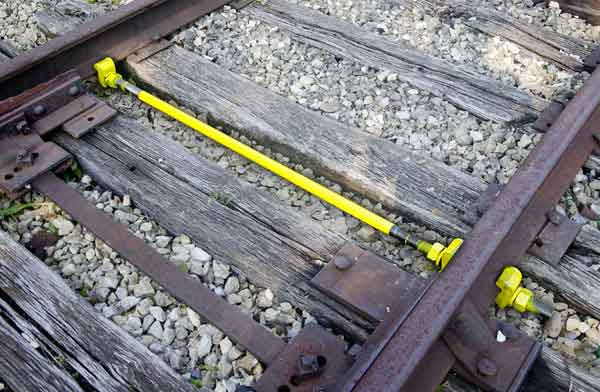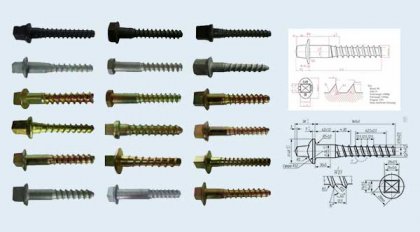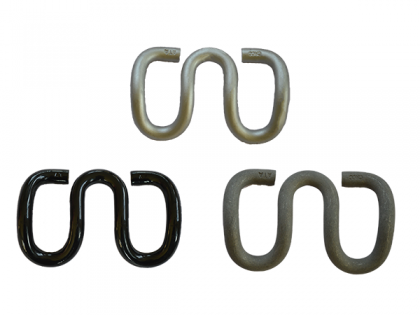Rail Gauge Rod
Rail gauge rod is also called gauge tie rod or gauge tie bar. As its name, rail gauge rod is a member bar that is specially designed to joint two steel rails at the rail bottom to protect the rails from tilting and keep the rails in certain rail gauge.


Types of rail gauge rods
As a professional manufacturer of rail gauge tie rod, AGICO can supply standard gauge rods for 56-½" track and rails of 60-140 lbs, for both non-insulated and insulated type, with approved certificate of ISO9001:2008 and CRCC authorization. Besides, we produce various kinds of gauge tie rods, such as AREMA 1-1/4 "insulated gauge tie rod, and other gauge rod used in UIC, BS rails, with length of 600mm,762mm,900mm,1435mm, etc.

Standard Gauge Rod
A standard gauge rod with two ends includes components of 1pcs rod, 4pcs iron card, 4pcs flat washer, 4pcs nuts, 4pcs spring washer, no matter for non-insulated, or insulated types.


Standard Gauge Rod
A standard gauge rod with two ends includes components of 1pcs rod, 4pcs iron card, 4pcs flat washer, 4pcs nuts, 4pcs spring washer, no matter for non-insulated, or insulated types.

| No. | Part | Quantity | Specification | Material |
|---|---|---|---|---|
| 1 | rod | 1 | M30 M36 | 3# |
| 2 | iron card | 4 | I type II type | KTH350-10 |
| 3 | plain washer | 4 | M30 M36 | 3# |
| 4 | nut | 4 | M30 M36 | 3# |
| 5 | spring washer | 4 | M30 M36 | 65Mn |
- Application: 43,50,60,75kg/m rail
- Operating temperature: -40~60 degrees Celsius
- Standard: TB/T1780-86
Non-standard gauge tie rod
It is to be produced by customizing depending on customers’ drawings and specific requirements.
It is to be produced by customizing depending on customers’ drawings and specific requirements.
The Importance of Rail Gauge Rod
As an important accessory for railroad tracks, rail gauge tie rod helps to improve the rails’ lateral stability and also the ability to keep rail distance. There are some railways that with track circuit, then it should use the insulated rail gauge rod which adopts high insulation resistance material to separate the circuit between two rails apart. Rail gauge may deviated if gauge tie rod is serious lacked, it may cause derailment or even overturned when the train passing by.
Made of two clamping devices at either end to fix railway tracks and a connected rod in the middle, a rail gauge rod fastens two parallel railways with certain gauge railway and prevents the rail from sliding.
For some weaker sections of rails, like in sharp curves, turnouts, bad ties and temporary track, rail gauge rods are quite necessary, they help to prevent the rail track from unbalanced longitudinal tension and keep regular rail gauges.

Made of two clamping devices at either end to fix railway tracks and a connected rod in the middle, a rail gauge rod fastens two parallel railways with certain gauge railway and prevents the rail from sliding.
For some weaker sections of rails, like in sharp curves, turnouts, bad ties and temporary track, rail gauge rods are quite necessary, they help to prevent the rail track from unbalanced longitudinal tension and keep regular rail gauges.

Features of rail gauge tie rod from AGICO
1. High Intensity
2. High Durability
3. Excellent Chemical Stability
4. Easy Operation
2. High Durability
3. Excellent Chemical Stability
4. Easy Operation
Influence factors of rail gauges
Traffic Condition:
If the intensity of traffic on the track is likely to be more, a gauge wider than the standard gauge is suitable.
Development of Poor Areas:
The narrow gauges are laid in certain parts of the world to develop a poor area and thus link the poor area with the outside developed world.
Cost of Track:
The cost of railway track is directly proportional to the width of its gauge.
If the fund available is not sufficient to construct a standard gauge, a metre gauge or a narrow gauge is preferred rather than having no railways at all.
Speed of Movement:
The speed of a train is a function of the diameter of wheel which in turn is limited by the gauge.
The wheel diameter is usually about 0.75 times the gauge width and thus, the speed of a train is almost proportional to the gauge.
If higher speeds are to be attained, the B.G track is preferred to the M.G or N.G track.
Nature of Country:
In mountainous country, it is advisable to have a narrow gauge of the track since it is more flexible and can be laid to a smaller radius on the curves.
This is the main reason why some important railways, covering thousands of kilometers, are laid with a gauge as narrow as 610 mm.
If the intensity of traffic on the track is likely to be more, a gauge wider than the standard gauge is suitable.
Development of Poor Areas:
The narrow gauges are laid in certain parts of the world to develop a poor area and thus link the poor area with the outside developed world.
Cost of Track:
The cost of railway track is directly proportional to the width of its gauge.
If the fund available is not sufficient to construct a standard gauge, a metre gauge or a narrow gauge is preferred rather than having no railways at all.
Speed of Movement:
The speed of a train is a function of the diameter of wheel which in turn is limited by the gauge.
The wheel diameter is usually about 0.75 times the gauge width and thus, the speed of a train is almost proportional to the gauge.
If higher speeds are to be attained, the B.G track is preferred to the M.G or N.G track.
Nature of Country:
In mountainous country, it is advisable to have a narrow gauge of the track since it is more flexible and can be laid to a smaller radius on the curves.
This is the main reason why some important railways, covering thousands of kilometers, are laid with a gauge as narrow as 610 mm.
Get In touch Now!
We receive enquiries in English, Español (Spanish), Русский язык (Russian), Français (French) and العربية (Arabic). Our professional team will reply to you within one business day. Please feel free to contact us!




